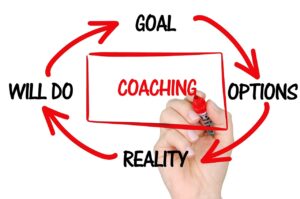What is coaching marketing, and why is it so critical in 2023 and beyond?
According to various searches I did, the coaching industry was expected to grow at an average yearly growth rate of 6.7% from 2019 to 2022. And the market size of the Business Coaching industry in the US has grown 2.3% per year on average between 2018 and 2023.
Additionally, the US life coaching market is expected to expand at a compound annual growth rate (CAGR) of 4.85% from 2023 to 2030.
In this fast growing world of coaching…
Setting yourself apart isn’t a luxury.
Enter: coaching marketing. Where blending creativity, strategy, and authenticity catapults your coaching business.
Don’t just survive. Thrive in this competitive but growing landscape.
Need Personalized Help From a Coach? RSVP for a Free Live Monthly Workshop
Table of Contents
ToggleUnderstanding your target audience and niche
In any business, understanding your target and niche = the foundation for crafting a marketing strategy.
For coaches, this step is even more essential. For LIFE coaches specifically, this step can be hard and take some time.
To do this, start by identifying your unique selling proposition (USP). What makes you stand out from other coaches in the industry? This may include your experience, expertise, coaching style, or even your personal story. Be as specific as possible, as this will serve as the guiding star for your marketing efforts.
It’s critical that 1) niche you decide on paint a picture for clients, and 2) that your tagline represent a “bleeding neck” problem. The “bleeding neck” principle described by John Paul Mendocha is a dire sense of urgency, an immediate problem that demands to be solved. Right. Now.
Examples
Vague:
“I help women practice self care.”
This could be a starting tagline, but there are a few problems here. First, is that we need to address a problem that is important enough that people will pay for it. There’s a lot of resources online about self care. Most people know they need it, but probably wouldn’t pay high ticket for it. Additionally, “women” is pretty broad. What kind of women? How old are they? What do they do? Where do they hang out?
Specific
“I help working moms recover from burnout by building resilience so they can be present for their family and themselves”.
This second version paints a picture, and describes a problem that needs to be solved more urgently. Burnout is often an urgent issue in and of itself. But for working moms, being present for your family is too. Your kids are young once, and a lot of women professionals struggle with guilt at not being present.
Once you’ve identified your USP, create a detailed profile of your ideal client. I like to start this process with market research. Aim to talk to 10-30 people that loosely fit into who you think your ideal client is. You can position these as no-pitch market research calls. OR, you can gather this data on your normal sales calls. (Up to you)
Your goals with market research:
- Make sure you understand the actual challenges and desires
- Write down the actual words people use – this is your marketing
- Validate that your offer is something people will pay for
It’s important to note that at this point, you probably DON’T feel clear on exactly what your niche is.
That’s ok: you will gain clarity over time by taking action. So, don’t let a lack of clarity stop you from moving forward.
On market research calls, ask:
- What challenges do they face?
- What are their goals, fears, and desires?
- What solutions have they tried that didn’t work?
- What is life like now?
- What do they want it to be like?
- How would that feel?
- How important is this to them?
Lastly, research your competition.
Analyze their marketing strategies, and their language. This helps you identify gaps in the market that you can fill. And it also provide valuable insights into what works and what doesn’t.
Understanding your target audience and niche is a continuous process. So, just get started and refine as you go.
Looking to get coaching clients? Here’s an article on that.
Offline versus online marketing for coaches
Some coaches focus solely on online marketing. Others focus only on in-person or offline marketing. I would encourage you to do what feels aligned and what works for you, but I think there are benefits to doing BOTH if you can manage it.
While digital marketing offers a ton of opportunities, algorithms are always changing. Having an offline component to your marketing can give you some extra safety.
With both types of marketing coaching, your goal is the same:
- Get visible
- For the purpose of getting leads
- ^^^ Leads = email addresses (or other contact info)
Offline marketing includes strategies like networking, speaking engagements, and print advertising. Attend events in your area, conferences, and workshops for building connections and finding more networking opportunities. I would also highly encourage you to offer to speak at events (even if it’s for free).
Or host your own events. (I just started doing this in Houston! Here’s my Meetup group.
Don’t forget about creating printed assets. Business cards, brochures, and even direct mail can still be highly effective in generating leads and raising awareness. (These methods have been around exponentially longer than social media…)
Online marketing, on the other hand, gives you leverage: the power of reaching a global audience. You should use some combo of content marketing, email marketing, search engine optimization (SEO), social media marketing, and maybe paid advertising to create an online presence.
Let’s dive in to the online strategies more.
Content marketing for coaches
Content marketing is basically what it sounds like. 🙂 Using copywriting, video, graphics, or otherwise for attraction marketing. Attraction marketing = drawing
Content is an inevitable component of online marketing. We create valuable and interesting content to capture attention and grow an audience, and this takes many potential forms. By consistently creating and sharing valuable content, you position yourself and forge connections with potential clients.
The first step in crafting a successful content marketing strategy is to identify the types of content that are a fit for your personality, AND will resonate with your target audience. (Start with your personality though. Don’t start a blog if you hate to write!)
Next, develop a content calendar to plan and schedule your content creation. This helps you stay organized and consistent. More importantly, it also helps make sure you’re creating content that is relevant to your coaching offer. Remember, the goal of content marketing is to provide value – AND build authority and trust for your niche.
Need ideas for content? Read about inspired content marketing.
Utilizing email marketing – lead magnet ideas for coaches
Email marketing is indispensable for ALL business owners, both offline and online. Email works by nurturing relationships, driving engagement, and ultimately converting leads into customers. Two other important things about email: First, you own the list. So, email offers more stability than social media because you can’t control algorithms, but you have the ability to send emails to your list consistently. Secondly, if you look at the effectiveness of social media versus email PER piece of content (one post, versus one email), a much higher percentage of your email subscribers see each email compared to the number of people that see a social media post.
These are just two of the reasons building my email list is a big priority!
So, we know the first step in a successful email marketing strategy is to grow your email list. The most effective way to do this? Offering a lead magnet.
A lead magnet is a free, valuable resource that you offer in exchange for a visitor’s contact information. For coaches, lead magnet ideas might include ebooks, whitepapers, checklists, templates, mini-courses, webinars, or even exclusive video content.
The key = ensure that your lead magnet addresses a specific problem or need that your target audience faces and provides a tangible solution or benefit.
Promoting Your Lead Magnet
To promote your lead magnet, create an opt-in form and place it on your website, blog, and social media channels. You can also use paid ads or collaborate with other people in your niche to expand your reach and get more subscribers.
Once you’ve started your email list, make sure to regularly communicate with your subscribers. I email my list twice a week, and alternate between pure value emails, and emails that also sell. You can email your list less, but I would aim for at least once monthly to stay top of mine. Share your latest content, updates, promotions, and success stories. BUT also always focus on giving value. Provide actionable tips, insights, and inspiration that empower your audience.
SEO strategies for coaching businesses
Another coaching marketing method: SEO.
Search engine optimization (SEO) is the process of optimizing online content to rank in search engine results (like Google) and drive organic traffic to your website.
For coaching businesses, SEO helps you attract potential clients who are actively searching for solutions and guidance related to your niche.
Many coaches don’t utilize SEO because it’s a long game / not a quick win. When you’re starting out, there’s definitely faster ways to get clients. But SEO can be a growing AND stable source of leads and clients over time.
One of the most critical aspects of SEO is keyword research.
Identify the keywords and phrases that your target audience is likely to use when searching for coaching services, advice, or information related to your field. Tools like UberSuggest (my favorite) or Google Keyword Planner, Moz, and SEMrush can help you find relevant, high-volume keywords with low competition. Ubersuggest basically shows you google keyword planner data in a more visual, organized way.
Once you compiled a list of keywords, incorporate them strategically into your website content, blog posts, and meta tags to improve your search engine rankings.
Another crucial component of SEO is link building. (This is way easier said than done tbh.)
When other people link to your website, (backlink) it signals to search engines that your content is valuable and trustworthy. Over time this results in higher search rankings.
To build backlinks, reach out to relevant websites in your niche and offer to create guest posts or co-authored articles. You can also engage in communities related to your niche and forge connections for collaborating.
Remember, SEO is an ongoing process. Blog regularly, monitor your rankings, analyze your data, and refine your strategy.
Social media marketing for coaches
Social media offers a wealth of opportunities for coaches to connect with their target audience globally. However, the key to successful social marketing lies in 1) understanding the nuances of each platform and tailoring your strategy accordingly and 2) consistency.
Start by figuring out the social media platforms that are most popular among your target audience AND align with your coaching niche.
For example, LinkedIn might be more suitable for coaches that work with corporate professionals. While Instagram could be a better fit for fitness or lifestyle coaches.
When it comes to content, variety is essential.
Share a mix of educational, inspirational, AND promotional content to keep your followers engaged while making sure your content is geared toward making money. This may include tips, mistakes people make, what’s changing in your industry, testimonials, success stories, or even behind-the-scenes glimpses into your business.
Finally, engage with your followers. This helps curate your visibility intentionally. Curating visibility = going after traffic, instead of just waiting for the algorithm.
Paid advertising and sponsorships
While organic marketing strategies such as content marketing and social media can be amazing, paid advertising and sponsorships can provide consistency and faster growth once your business is established.
***Do not do paid ads if your offer and audience aren’t dialed in. You will waste a ton of money 🙃
Paid advertising on platforms such as Google Ads or Facebook, Instagram, and LinkedIn allow you to target specific audience demographics and interests, track your ad performance, and adjust your budget and targeting in real-time.
Consider running ads for specific services, promotions. Or for lead magnets to grow your email list faster.
Sponsorships
Sponsorships are another way to reach a wider audience and establish credibility in your niche.
Partner with complementary brands, influencers, or organizations that share your values. Then offer to sponsor events, podcasts, webinars, or even social media posts.
This can help you tap into their existing following and build your own awareness and authority within your niche.
30 Ways to Market Your Coaching Business
The ideas below expand on the education above.
buckle up buttercup!
- Industry events, conferences, and workshops for networking
- Offer to speak at these events or host your own workshops
- Build a website
- Start a blog
- Utilize guest blogging to expand your reach
- Create a free lead magnet to attract potential clients and grow your email list
- Leverage email marketing to nurture relationships
- Search engine optimization (SEO) to drive traffic to your blog or website
- Leverage collaborations in your social media
- Pay-per-click (PPC) advertising
- Social media marketing
- Influencer marketing to tap into existing audiences
- Video content (YouTube, TikTok, Instagram)
- Host webinars
- Podcasts
- Testimonials and success stories
- Case studies (longer form and more technical than a testimonial)
- Online forums and communities (Reddit, Quora, Facebook)
- Print advertising
- Direct mail
- Public relations
- Joint ventures and partnerships
- Referral marketing
- Guerrilla marketing
- SMS (text) marketing
- Chatbots to provide personalized support (Facebook, website)
- Quizzes and assessments (make good lead magnets)
- Surveys and polls
- Content upgrades (tripwires) to provide additional value to your audience
- Exit-intent popups (on your website)
How to get coaching leads to become sales
Generating leads is only the first step.
To turn them into sales, you need to nurture these relationships and guide them through your sales funnel. Here are some tips to help you convert your coaching leads into loyal customers:
- Communicate consistently – Email, post and/or show up consistently consistently to stay top of mind
- Educate your leads – offer valuable content that showcases your coaching expertise and addresses their challenges.
- Showcase results – share testimonials, case studies, and success stories that demonstrate the value of your coaching services.
- Provide a calls-to-action – guide your leads through the next steps in your sales funnel, such as scheduling a call or buying a low cost offer
- Offer incentives – provide discounts, bonuses, or exclusive content to encourage your leads to take action.
Conclusion
Marketing your coaching business may seem overwhelming at first. But with the right strategies and mindset, you will be rewarded...By helping people while actually making money 🙃
Remember to stay true to your unique selling proposition. Understand your target audience and niche, and tailor your marketing efforts to their specific needs and preferences.
And most importantly, focus on building GENUINE connections with your clients and audience, and providing value every step of the way.
You can’t quit if you don’t fail 🧡






